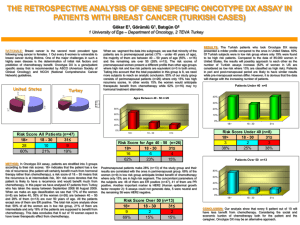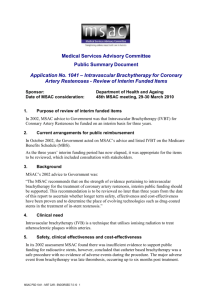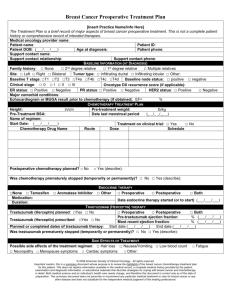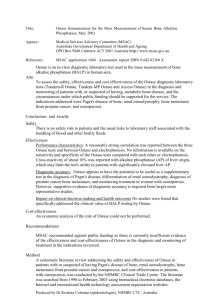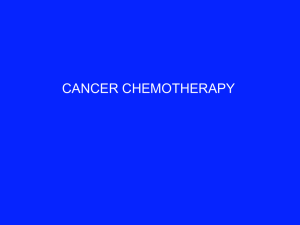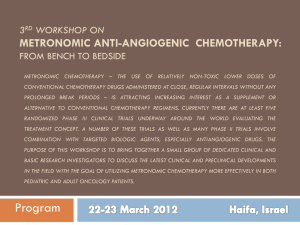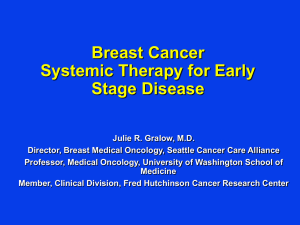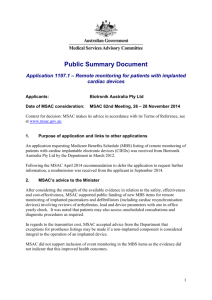17. Applicant`s comments on MSAC`s Public Summary Document
advertisement
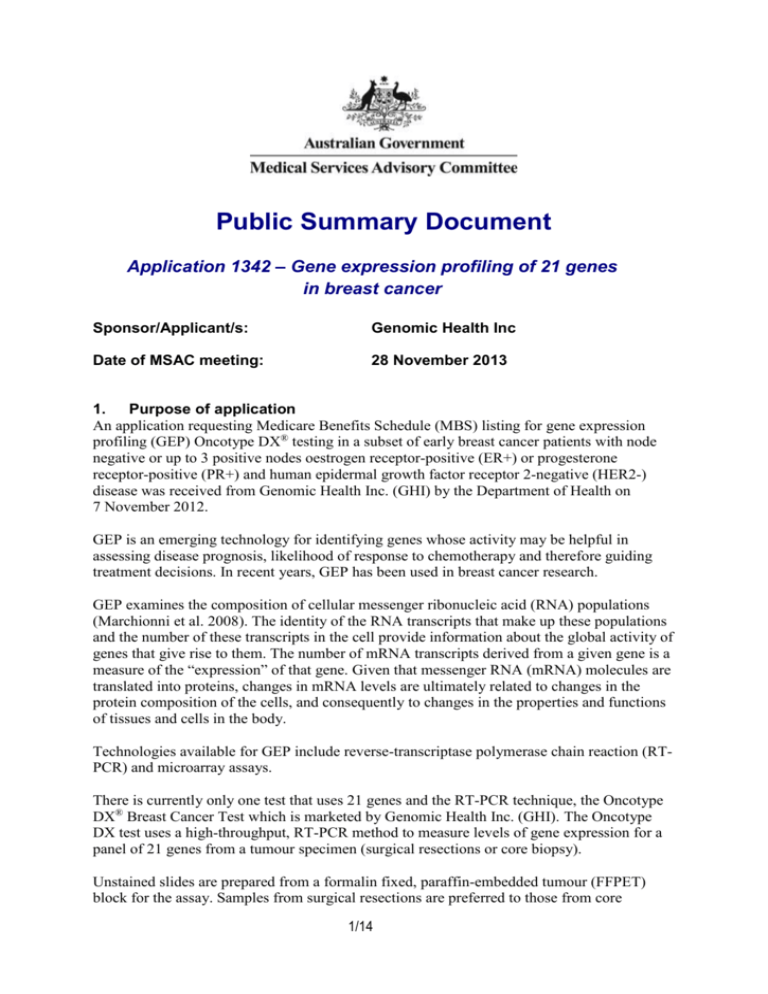
Public Summary Document Application 1342 – Gene expression profiling of 21 genes in breast cancer Sponsor/Applicant/s: Genomic Health Inc Date of MSAC meeting: 28 November 2013 1. Purpose of application An application requesting Medicare Benefits Schedule (MBS) listing for gene expression profiling (GEP) Oncotype DX® testing in a subset of early breast cancer patients with node negative or up to 3 positive nodes oestrogen receptor-positive (ER+) or progesterone receptor-positive (PR+) and human epidermal growth factor receptor 2-negative (HER2-) disease was received from Genomic Health Inc. (GHI) by the Department of Health on 7 November 2012. GEP is an emerging technology for identifying genes whose activity may be helpful in assessing disease prognosis, likelihood of response to chemotherapy and therefore guiding treatment decisions. In recent years, GEP has been used in breast cancer research. GEP examines the composition of cellular messenger ribonucleic acid (RNA) populations (Marchionni et al. 2008). The identity of the RNA transcripts that make up these populations and the number of these transcripts in the cell provide information about the global activity of genes that give rise to them. The number of mRNA transcripts derived from a given gene is a measure of the “expression” of that gene. Given that messenger RNA (mRNA) molecules are translated into proteins, changes in mRNA levels are ultimately related to changes in the protein composition of the cells, and consequently to changes in the properties and functions of tissues and cells in the body. Technologies available for GEP include reverse-transcriptase polymerase chain reaction (RTPCR) and microarray assays. There is currently only one test that uses 21 genes and the RT-PCR technique, the Oncotype DX® Breast Cancer Test which is marketed by Genomic Health Inc. (GHI). The Oncotype DX test uses a high-throughput, RT-PCR method to measure levels of gene expression for a panel of 21 genes from a tumour specimen (surgical resections or core biopsy). Unstained slides are prepared from a formalin fixed, paraffin-embedded tumour (FFPET) block for the assay. Samples from surgical resections are preferred to those from core 1/14 biopsies to ensure that the most representative invasive tumour component is sent for analysis. Core biopsies are accepted, in rare instances when surgical resection tissue is not available, as analytical methods have also been standardised to assay these tissue sources. All tissue samples are assessed by a pathologist at GHI to verify the diagnosis and to perform manual microdissection as needed in accordance with pathology guidelines. The assay generally requires 2mm of invasive tumour tissue for successful analysis. The histological examination of the tumour biopsy is performed by an Australian pathology laboratory using the Oncotype DX® Specimen Kit (obtained through the distributors of Oncotype DX® in Australia, Healthscope (Dandenong, Victoria)). The current arrangement is that GHI pays an administrative fee to the distributor who then reimburses the pathology company for the costs of sample preparation. The laboratory prepares the specimen: 15 unstained slides each with (5microns) section of tissue, each slide must be numbered 1 through 15, in order of sequential sectioning, OR; One fixed paraffin embedded tumour block The specimen and a requisition form are sent to Healthscope who then ship the specimen to a central laboratory in the United States of America (USA). The results of the Oncotype DX® test are available within 10-14 days from the date the tumour sample is sent to the central laboratory. From the gene expression profiling, a Recurrence Score (RS) between zero and 100 is calculated to correspond to a point estimate of the 10-year risk of distant recurrence with a 95% confidence interval for an individual patient. The Recurrence Score is used to define three distinct risk groups: low risk (RS < 18), intermediate risk (RS 18-30), and high risk (RS ≥ 31). This is a new intervention as there is no tumour specific chemotherapy subtyping tool available to determine the likelihood of benefiting from adjuvant chemotherapy. Currently GEP testing is not eligible for reimbursement under Medicare. Breast cancer is a disease in which abnormal cells, most commonly originating from the terminal duct lobular unit of the breast, transform and develop into an invasive tumour. These tumours can invade and damage the tissue around them, and spread to other parts of the body, such as the bones, liver, lung and brain, through the lymphatic or vascular systems (AIHW & NBOCC 2009). Breast cancer is the most common cancer among Australian women, accounting for 27% of all cancer diagnoses and with an average age of first diagnosis of 60 years in 2007 (AIHW & AACR 2010; AIHW & NBOCC 2009). The applicant proposed GEP of 21 genes using the RT-PCR technique in patients with the following disease characteristics: Early breast cancer (stages I-II); Suitable for hormone therapy; Suitable for adjuvant chemotherapy; ECOG performance status 0-2; Invasive tumour >2 mm; Node negative or 1-3 positive nodes; ER+ or PR+ as determined by Immunohistochemistry (IHC); and HER2 negative as determined by IHC and/or in situ hybridisation(ISH). 2/14 2. Background There has been no previous MSAC consideration of GEP in breast cancer. 3. Prerequisites to implementation of any funding advice This application related to a test that is conducted in a single laboratory in the USA and so not subject to regulation by the Australian Therapeutic Goods Administration (TGA). In vitro diagnostic medical devices (IVDs), such as Oncotype DX®, are currently not required to be registered on the Australian Register of Therapeutic Goods (ARTG); however, under the TGA regulatory framework introduced in July 2010, IVDs provided in Australia will be required to be registered as of July 2014. The Oncotype DX® assay is registered in the USA only as it is a test service that is exclusively performed in a single laboratory located in California, USA. The laboratory is certified to perform such testing with the United States’ Centers for Medicare and Medical Service (CMS) and accredited by the College of American Pathologists (CAP) under the United States Clinical Laboratory Improvement Amendment (CLIA) of 1988 and operates in accordance with federal and state laws. 4. Proposal for public funding Applicant Proposed MBS item descriptor MBS [item number] (proposed MBS item) Pathology Group P7 Genetics Gene expression profiling of tumour samples (surgical resection preferably or core biopsy) by reverse-transcriptase polymerase chain reaction (RT-PCR) technique for 21 genes in breast cancer tissue. May only be used to test samples from patients with the following characteristics as determined by the referring clinician: early breast cancer (stages I-II) suitable for hormone therapy suitable for adjuvant chemotherapy ECOG performance status 0-2 and As determined by an Australian pathology laboratory invasive tumour >2mm node negative or 1-3 positive nodes oestrogen positive or progesterone positive as determined by immunohistochemistry HER2 negative as determined by immunohistochemistry and/or in situ hybridisation May only be used once per new primary breast cancer diagnosis Fee: $(redacted) The application proposed an MBS fee of $(redacted) to cover the costs of collecting and preparing the sample (performed in Australia), shipping the sample overseas, performing the test in the applicants laboratory, reporting the results and returning the sample to Australia. The application stated that the majority of the MBS fee is the cost for performing the assay and delivering the results, whereas the cost of obtaining the Oncotype DX® Specimen Kit amounts to a small fraction of the proposed MBS fee. The applicant (GHI) is willing to negotiate the MBS fee to ensure equitable and cost-effective access in Australia. Any patients deemed not suitable for chemotherapy or unable to tolerate chemotherapy would be ineligible for the GEP test. 3/14 Patients diagnosed with node-negative or 1–3 positive nodes, ER+ or PR+, HER2-, early (stage I or II) breast cancer with an invasive tumour >2 mm who are suitable for chemotherapy would be eligible for the GEP test. Patients who have received neoadjuvant chemotherapy would continue to receive chemotherapy therefore the GEP test would not be required for the treatment decision. Ordering of the GEP test should be restricted to oncologists or surgeons, once patients are diagnosed with node-negative or 1–3 positive nodes, ER+ or PR+, HER2-, early stage breast cancer. 5. Consumer Impact Statement Feedback from consumers and professional bodies broadly supported GEP testing because knowledge of the susceptibilities of a patient’s breast cancer to chemotherapy and /or endocrine therapy allows more informed treatment decisions with appropriate combinations of therapy for the majority of women. For women with a recurrence score which indicates chemotherapy is not required, there are advantages in avoiding a toxic treatment and its associated side effects that may ultimately be of no benefit to them. The current cost of the test was consistently raised as being out of reach for most women; therefore it was considered that listing the test would make access more equitable. It was acknowledged that whilst the test is not perfect, it is an important tool to assist women in making decisions regarding their treatment. 6. Proposed intervention’s place in clinical management Australian clinical experts contacted during scoping felt that molecular classification would be used in the clinical setting as an adjunct to current clinical practice rather than replacing any part of it. The application stated that there is no change in the treatment algorithm between the current and proposed pathways for patients in Australia diagnosed with breast cancer (Figure 1). The pathway reflects the assessment of all patients diagnosed with breast cancer up to the point of surgery. The biopsies from all patients are tested using IHC to determine hormone and HER2 status. The post-operative assessment of tumour size and degree of lymph node involvement is used to define the patient’s stage of disease. It was proposed that the GEP test is an adjunctive test following surgery for a subgroup of patients who are classified as stage I or II, ER+ or PR+ and HER2– with 0-3 positive lymph nodes. The GEP test results would be used to guide the use of adjuvant chemotherapy in addition to existing prognostic approaches based on tumour staging, histological features and lymph node involvement. Any patients deemed not suitable for chemotherapy or unable to tolerate chemotherapy would not be eligible for the GEP test. Expert opinion sought on the time to commence adjuvant chemotherapy after surgery indicated that treatment usually commenced within 3-6 weeks after surgery. The results of the GEP test are available within two weeks of the sample being sent to the Genomic Health laboratory in the US therefore there was no anticipated delay for treatment to commence. In less than 10% of cases there was a need for repeat testing. The algorithm considers all patients with early breast cancer (stage I-II) who undergo primary surgical resection. 4/14 Figure 1: The current diagnosis and management pathway in breast cancer with proposed positioning of the Oncotype DX® test. Breast needle core biopsy diagnosis of cancer IHC for ER and HER2 Assess ER & HER2 status, age, suitability for surgery Primary surgical resection Neoadjuvant chemotherapy e.g. poor prognosis large tumour1 Primary endocrine therapy e.g. ER+ unfit for surgery2 Assess with postoperative results from resection specimen ONCOTYPE DX for patients who are ER+, HER2- and LN ≤3 No No Satisfactory Sample & Test Resubmit sample and/or repeat ONCOTYPE DX test (~10%) (~10%) (at cost to GHI) Yes Yes Endocrine therapy only Adjuvant chemotherapy & endocrine therapy 1 Patients who have received neoadjuvant chemotherapy will continue to receive chemotherapy and therefore Oncotype DX will not be required for the treatment decision 2 Patients who are unfit for surgery would also be deemed unfit for chemotherapy and therefore Oncotype DX will not be required for the treatment decision 7. Other options for MSAC consideration MSAC discussed the currency of evidence used to validate the GEP test and that diagnostic practice has improved and treatment has changed, potentially eroding any difference between the test and the comparator. 5/14 8. Comparator to the proposed intervention The application nominated usual care (defined as traditional clinical judgement based on clinical (for example, age, menopausal status), pathological (tumour size, tumour grade) and molecular (ER, PR, HER2) parameters to estimate the risk of recurrence by combining them in informal or formal algorithms (eg. Adjuvant! Online)) as the appropriate main comparator. MSAC accepted that the comparator for the 21-gene expression profiling test is usual care, defined as traditional clinical judgement based on clinical, pathological and molecular parameters to estimate the risk of disease recurrence. MSAC was also aware of other predictive tests in breast cancer, such as IHC-4, which also rely on gene profiling based primarily on proliferative predictors for breast cancer in the gene set (for example, ER, PR, HER2 and Ki-67 expression), but are also not publicly funded in Australia. MSAC considered that a wider comparison across these alternative predictive tests in terms of clinical validity (prognostic value), clinical utility (predictive value of different treatment outcome), costs and cost-effectiveness would also be informative. 9. Comparative safety The application presented no comparative safety data but noted “Given this is a gene expression test on tissue that was removed during surgery for breast cancer (i.e. not specifically for the test), there are no relevant safety issues.” MSAC noted that as this test is not registered with TGA, there is no control in Australia in relation to quality assurance and quality control issues. The question of who would be held accountable if potential issues arose needs to be considered. MSAC noted that although the test is procedurally safe because it relies on samples already taken for other purposes, there is a degree of risk in the misallocation of patients to risk categories, which would affect the outcomes of the therapy subsequently selected. 10. Comparative effectiveness The basis of the clinical utility of the test in the application was retrospective analyses of tumour samples from patients randomised in two randomised comparative trials comparing tamoxifen alone and tamoxifen in combination with chemotherapy (Paik et al (2006) and Albain et al (2010)). The Paik results indicated that there are no statistically significant differences between tamoxifen plus chemotherapy and tamoxifen alone for patients classified as low or intermediate risk by the GEP test for the outcome of distant disease-free survival. However, for those categorised as high risk, there is a statistically significant difference between tamoxifen plus chemotherapy compared with tamoxifen alone, favouring tamoxifen plus chemotherapy. Importantly, for both of these outcomes, the results for “all” patients, which is a sub-group of the entire Fisher et al (1997) trial population, demonstrated a statistically significant difference between tamoxifen plus chemotherapy and tamoxifen alone, such that the further sub-group analyses presented are somewhat reasonable, although being considered post-hoc and exploratory. The results reported in Albain indicated there was improved disease-free survival over 10 years for chemotherapy plus tamoxifen (CAF-T) versus tamoxifen alone in the entire sample included in the analysis (stratified log-rank p=0.054, adjusted for number of positive nodes). However, no statistically significant differences between CAF-T and tamoxifen alone 6/14 were observed for the low and intermediate risk sub-groups. The publication and the application claim that “for high risk patients (RS >31) there was a significant advantage of treatment with CAF-T compared with tamoxifen alone (HR=0.59; 95% CI: 0.35, 1.01)”. This was not a statistically significant difference, although it is approaching significance. Similar differences in the predictive value of the RS were seen for overall survival over 10 years. MSAC noted that the Paik et al (2006) data were less persuasive because using chemotherapy concomitantly with tamoxifen produced a negative interaction, whereas the Albain et al. (2010) data were more persuasive because tamoxifen was used after completion of chemotherapy. However, the score also does not predict the risk of chemotherapy-resistant recurrence. MSAC also noted that the derived recurrence score could not be related back to the underlying biology of breast cancer, and there was not a clear justification of the three risk categories. Overall, MSAC noted that this remained moderate evidence of weak prognostic and predictive value. 11. Economic evaluation The economic evaluation presented was a cost-utility analysis, consistent with the clinical claim. The model had two treatment arms: (i) GEP testing (Oncotype DX®) and (ii) usual care. Firstly, a decision impact module distributed the cohort into six partitions based on underlying RS category (High risk, Intermediate Risk, Low Risk) and treatment allocation; chemotherapy + hormone therapy (CT+HT) or hormone therapy (HT) alone. The underlying RS category is the same in the GEP test and usual care arms of the model. However, the treatment allocation will differ because of the information provided by the GEP test. Secondly, a Markov model was used to follow each of these cohorts for the lifetime of the economic model. The model determined risk of disease recurrence based on node status (node negative or node positive), the underlying GEP test risk score and the treatment (CT+HT or HT alone) being received. From these disease recurrence risks, the Markov model projected life expectancy, quality-adjusted life expectancy and direct costs. Risk of recurrence based on 10 years of follow-up in the two studies was extrapolated to the 30 year time horizon of the analysis. Results of the economic evaluation – node negative population Component Costs Oncotype DX $17,862.88 13.27 QALYs Incremental cost-effectiveness ratio (ICER) Usual care $15,171.46 Increment $2,691.42 13.13 0.14 $18,899 Results of the economic evaluation – node positive population Component Costs Oncotype DX $46,026.17 Usual care $45,741.14 Increment $285.02 10.86 10.81 0.04 $6,590 QALYs Incremental cost-effectiveness ratio The ICERs estimated in the application were not considered completely relevant to the Australian context as: Although anastrozole is the most commonly used hormone therapy in Australia, the patients in the model are assumed to be treated with tamoxifen and the risk of recurrence observed for tamoxifen is used. Anastrozole has demonstrated disease-free and overall 7/14 survival benefits compared with tamoxifen and thus the risk of recurrence is likely to be lower in patients treated with anastrozole. The price for tamoxifen is used in the model and anastrozole is more expensive. The relative risk reductions used in the model for the addition of chemotherapy are derived from those observed/estimated in the comparison of tamoxifen ± MF/CMF or CAF while the costs of the additional chemotherapy are those for AC or FEC-D which are the most commonly used regimens for node negative and node positive breast cancer in Australia based on expert opinion and a survey of 12 oncologists and surgeons. The assumed treatment changes in the model were based on those recommended in de Boer et al (2013) rather than the actual treatments received. The actual treatment changes occurred less frequently than the recommended treatment changes. Both models were sensitive to the assumed net change in chemotherapy and the assumed recurrence rates, the two key variables in the model that were identified as being uncertain to the Australian context for the reasons identified above. Using the lower 95% confidence limit for risk of recurrence and the lowest estimates of net change based on the 95% CIs (ie, the lower confidence limits for all except for low RS patients where the upper confidence limits of -0.6% and -5.1% for node-negative and nodepositive patients, respectively were used), the resulting ICERs are $138,188/QALY and $309,705/QALY for node-negative and node-positive patients, respectively. The ICER applicable to the Australian population was considered likely to lie somewhere between these ICERs and the base case ICERs specified above. However, this does not include any changes to the relative risk reductions that may be seen for the hormone therapy and chemotherapy regimens most commonly used in Australia: anastrozole ± AC or FEC-D. MSAC expressed concerns that the economic modelling was performed on the basis of cost of tamoxifen therapy, when anastrozole is more frequently used in Australia, and that the model likely overestimates clinical utility. MSAC did not accept the estimated incremental cost-effectiveness ratios, noting that they were most sensitive to the extent of change in subsequent decisions to use chemotherapy, and to the consequences of these changes in use of chemotherapy. 12. Financial/budgetary impacts The requested price per Oncotype DX test was $(redacted) and the proposed listing specified that the GEP test “may only be used once per new primary breast cancer diagnosis”. The application estimated that there would be 1,789 services in Year 1, increasing to 3,882 services in Year 5. The application estimate of the number of services per year was considered likely to be underestimated because of uncertain and potentially low estimates for numbers of eligible patients and rate of uptake for the GEP test. The net impact to Government health budgets was estimated to be approximately $5 million in Year 1, increasing to approximately $10 million in Year 5. This estimate was considered uncertain due to potentially (i) underestimated numbers of eligible patients, (ii) underestimated uptake rates; (iii) overestimated patient co-payments for the GEP test and (iv) differences between changes in recommendations and actual treatments undertaken for patients undergoing GEP testing. 8/14 13. Other significant factors Nil. 14. Key issues for MSAC from ESC ESC discussed that the limited evidence available could not confirm the parity of the IHC4 test for the prognosis for distant recurrences compared with the GEP test. ESC was concerned that the submission presented the clinical utility of the GEP test based on re-analyses of tumour samples from patients in earlier trials comparing tamoxifen alone and tamoxifen in combination with (older forms of) chemotherapy. ESC noted there was an ongoing trial in UK, the OPTIMA trial, where patients are randomised to HT+chemotherapy or an arm in which the decision regarding HT alone or HT+chemotherapy is based on the Oncotype DX recurrence score (results are expected in 2015). ESC noted the TAILORx multicentre randomised phase III trial (with n>10,000), being conducted in US, Canada, Europe, South America, and Australia that is investigating if HT alone is non-inferior to HT+chemotherapy in [node-negative] patients with an intermediate Oncotype DX recurrence score. Interim data are expected in 2015. However, the trial does not compare women who do as opposed to those who do not have a GEP test. ESC was concerned that the 21 gene model was not sufficiently investigated to enable external validation. ESC was not convinced there was adequate justification provided for the proposed fee of $(redacted) for Oncotype DX. 15. Summary of consideration and rationale for MSAC’s advice MSAC considered an application requesting public funding via an arrangement like the MBS for gene expression profiling of 21 genes in breast cancer tumours as a means to determine the likelihood of disease recurrence, and to predict response to chemotherapy, in women with the following disease characteristics: early breast cancer (stage I-II) suitable for hormone therapy suitable for adjuvant chemotherapy ECOG performance status 0-2 invasive tumour >2 mm node negative or 1-3 positive nodes oestrogen receptor (ER) positive or progesterone receptor (PR) positive as determined by immunohistochemistry (IHC) human epidermal growth factor receptor 2 (HER2) negative as determined by IHC and/or in situ hybridisation. Currently in Australia around 10% of women diagnosed with breast cancer with these disease characteristics have recurrent tumours despite hormone therapy. Less than half of these women get adjuvant chemotherapy, a decision currently based on clinical criteria, scoring systems and medical expertise. There is potential for both under- and over-treatment with adjuvant chemotherapy in addition to hormone therapy. The 21-gene expression profiling test was designed to better identify who should receive adjuvant chemotherapy. 9/14 MSAC noted that the Oncotype DX® Breast Cancer Test, which is marketed by the applicant, is the only test currently available that assesses 21 genes using a reverse-transcriptase polymerase chain reaction (RT-PCR) technique. MSAC noted that the applicant’s 21-gene expression profiling test is not currently eligible for reimbursement under Medicare, but is available to patients privately and has been used by several hundred Australian women. MSAC noted that there is only a single laboratory performing the test which is located in the USA and so is not subject to Australian standards through the TGA or the National Association of Testing Authorities (NATA). The GEP test is performed on paraffin-embedded breast tumour tissue which is shipped from the collecting laboratory in Australia to the California-based laboratory. The 21-gene expression profiling test assesses the protein-specific RNA expression levels of 16 genes associated with higher risk of disease recurrence. The expression level of each of these genes is firstly normalised with reference to five ‘house keeping’ genes. The relative levels of expression are then weighted into seven groups, the groups are further weighted to give a raw score and this is transformed into a ‘recurrence score’ that is finally used to categorise patients as having a low, medium or high risk of disease recurrence. The mathematic rules which comprise the calculation of this algorithm were transparently presented, but some aspects of the 21-gene expression profiling test appear to be arbitrary and subject to change. For example, the cut-points to determine the categorisation of low, medium and high risk changed between the retrospective analyses which formed the primary evidence base presented for the test (Paik et al., 2004, N Engl J Med 351:2817-26; Paik et al., 2006, J Clin Oncol; 24:3726-34; Dowsett et al., 2010, J Clin Oncol; 28: 1829-34; and Albain et al., 2010, Lancet Oncol; 11: 55-65, using cut-point recurrence scores of 18 and 31), and a prospective assessment involving the test which is currently underway (TAILORx, using cutpoint recurrence scores of 11 and 25). With so many other aspects also subject to change, it cannot be assumed that the overall test used to generate the evidence base is the same overall test that will be performed for Australian patients currently or in the future. MSAC also considered that the predictive power of these tests is likely to be heavily weighted by the status of HER2 (and related) genes, and considered that it would be informative to see an analysis of the incremental predictive power of expression profiling tests when used for the proposed target population, specifically those who are known to be HER2 negative. MSAC accepted that the comparator for the 21-gene expression profiling test is usual care, defined as traditional clinical judgement based on clinical, pathological and molecular parameters to estimate the risk of disease recurrence. MSAC noted that current clinical judgement is not as standardised as the information provided by the proposed test. MSAC was also aware of other predictive tests in breast cancer, such as IHC-4, which also rely on gene profiling based primarily on proliferative predictors for breast cancer in the gene set (for example, ER, PR, HER2 and Ki-67 expression), but are also not publicly funded in Australia. MSAC considered that a wider comparison across these alternative predictive tests in terms of clinical validity (prognostic value), clinical utility (predictive value of different treatment outcome), costs and cost-effectiveness would also be informative (for example, the comparisons of Cuzick et al, 2011, J Clin Oncol; DOI: 10.1200/JCO.2010.31.2835 and Ward et al., 2013 Health technology assessment (Winchester, England); 17(44):1-302. DOI:10.3310/hta17440). MSAC noted that it was currently possible to bill the MBS for the four IHC tests that contribute to the IHC-4, but not as a package also involving the calculation of a score based on the IHC results combined with classical clinical factors. 10/14 MSAC noted that the primary biological rationale for the test is that the levels of certain protein-specific RNAs will correlate with future cancer behaviour. By definition, the complex transformations of the raw analytical data render the question of analytical validity meaningless, in that there is no reference standard for the product of the proposed 21-gene expression profiling test. MSAC noted that the application reported that the analytical parameters have remained stable over 200,000 assays over six years and that within-patient reproducibility using different sections and different runs produced a standard deviation of 2.2 units. However, MSAC was unsure how to interpret the latter result, for example does the standard deviation vary with increasing recurrence score, and how often does a different section or a different run result in crossing cut points and thus a different risk categorisation (for example, from a high to an intermediate recurrence score). The proposed 21-gene expression profiling test was derived from an initial 250 proteinspecific RNAs analysed for an association with risk of disease recurrence. Although the test shows some clinical validity in determining the likelihood of disease recurrence through a prognostic correlation between increasing recurrence score at baseline and increasing risk of disease recurrence based on retrospective analyses of subgroups of patients (Paik et al., 2004 in node-negative patients; Dowsett et al., 2010 in both node-negative and node-positive patients; and the tamoxifen-only arms of Paik et al, 2006 and Albain et al., 2010), MSAC noted that this remained moderate evidence of weak prognostic value. In particular, MSAC noted that the derived recurrence score could not be related back to the underlying biology of breast cancer, and there was not a clear justification of the three risk categories. The evidence for clinical utility of the 21-gene expression profiling test comes from retrospective analyses of tumour samples from subgroups of patients in two randomised trials that compared tamoxifen alone and tamoxifen in combination with chemotherapy. Unlike the proposed patient population, the HER2 status of the patients in the clinical trials was unknown. Results from these retrospective analyses suggest that the test could predict differences in disease-free survival with the addition of chemotherapy in patients classed as having high risk of disease recurrence, but not in patients classed as having low or intermediate risk (Paik et al, 2006 in node-negative patients and Albain et al., 2010 in nodepositive patients). MSAC noted that the Paik et al., 2006 data were less persuasive because using chemotherapy concomitantly with tamoxifen produced a negative interaction, whereas the Albain et al., 2010 data were more persuasive because tamoxifen was used after completion of chemotherapy. The score also does not predict the risk of chemotherapyresistant recurrence. MSAC remained concerned that this remained moderate evidence of weak predictive value. Beyond the concerns already identified in the context of prognostic value, MSAC noted that most of the data points involved recurrence scores in the low and intermediate categories where the predictive value was low. More importantly, there was not a clear basis to extrapolate from the breast cancer therapies used in the analysed trials (for example, using tamoxifen as hormone therapy) to current or future therapies (for example, using anastrozole as hormone therapy) in Australia given the difficulty in relating the generated correlations to the underlying biology of breast cancer. MSAC noted that the clinical applicability of the 21-gene expression profiling test remains unclear. In particular, there is little experience in integrating this scoring system with other clinical and pathological parameters. There is also a lack of data relevant to the Australian population. MSAC also considered the safety of the test and noted that, although the test is procedurally safe because it relies on samples already taken for other purposes, there is a degree of risk in the misallocation of patients to risk categories, which would affect the outcomes of the therapy subsequently selected. There are no prospective data directly 11/14 demonstrating changes to patient-relevant health outcomes as a consequence of using this test. MSAC noted that a separate evidence base was presented to support estimates of the extent to which addition of the test to current clinical management would change subsequent therapy decisions, mostly to decrease the use of chemotherapy for patients with low recurrence scores and increase the use of chemotherapy for patients with high recurrence scores. This suggested that, on average, about five patients needed to be tested for one patient to have her clinical management changed. This number varied between three and eleven, indicating the difficulty in estimating the incremental effect of adding the test to current practice which varies widely in its adoption of other clinical and pathology parameters in common use. MSAC discussed that the economic modelling was performed on the basis of cost of tamoxifen therapy, when anastrozole is more frequently used in Australia, and that the model likely overestimates clinical utility. MSAC did not accept the estimated incremental costeffectiveness ratios, noting that they were most sensitive to the extent of change in subsequent decisions to use chemotherapy, and to the consequences of these changes in use of chemotherapy. As already noted, these two variables were weakly supported. MSAC also expressed concern at the high requested cost of $(redacted information) per test, and noted that the (redacted information) out-of-pocket (OOP) cost to the patient of $(redacted information) (assuming that $(redacted information) is charged and an 85% rebate applies) may not be realistic in the context of publicly funding a test. MSAC considered advice from its ESC on the financial implications of publicly funding the 21-gene expression profiling test. The net impact to government health budgets is estimated to be approximately $5 million in year one, increasing to approximately $10 million in year five. Estimated financial savings to the PBS budget from reduced chemotherapy use is subject to the same uncertainty as in the economic evaluation. MSAC also noted the potential for the test to be requested for other patients with early breast cancer without clear clinical justification for the increased costs, but noted that there were no mechanisms available to mitigate this potential. MSAC questioned the development of arrangements to publicly fund a test that is available only outside Australia with the potential for delay in results and lack of local quality assurance. In addition, the request precludes implementation of the applicant’s test in Australia. Consumer perspective MSAC considered consumer advice that consumers perceive an advantage in using the GEP test (Oncotype DX® Breast Cancer Test) as a means to aid decision making regarding chemotherapy and a potential tool to avoid unnecessary treatment. However, the potential for ambiguous test results would require a well-designed process for obtaining informed consent, and for counselling once the results are received. The OOP cost is perceived to be high and would raise concerns about access and equity. Lay Summary In Australia, around 15,000 women will be diagnosed with breast cancer each year. Despite improvements in therapies, around 10% will have recurrent tumours. The decision about whether to treat these women with adjuvant chemotherapy is complex and based on clinical criteria, medical expertise and patient choice. There is potential for both under-treatment – that is, women who don’t receive chemotherapy who would have benefitted – and over12/14 treatment – that is, women who receive chemotherapy with its negative effects but without benefit. The 21-gene expression profiling test (OncotypeDX® Breast Cancer Test) aims to predict which cancers have a higher chance of recurring by assessing the different types of proteins that are expressed in each tumour. There is weak evidence to suggest that a high score denotes a higher chance of disease recurrence and a greater likelihood of a woman benefitting from chemotherapy. Based on a review of this evidence, MSAC found that there are still unanswered questions about the clinical usefulness of the proposed GEP test. MSAC also noted the high cost of the GEP test, including the residual high costs to patients even if the test were publicly funded. MSAC advised that the 21-gene expression profiling test not be publically funded at this time. 16. MSAC’s advice to the Minister After considering the strength of the available evidence in relation to the safety, clinical effectiveness and cost-effectiveness of the proposed 21-gene expression profiling test, MSAC does not support public funding for its use to guide therapeutic decision making in breast cancer. MSAC also advised that it would be prepared to reconsider the application via the Evaluation Sub-Committee when the applicant has: prospective data regarding the predictive value of the test beyond its prognostic value and thus its clinical utility in improving subsequent decisions about which patients should and should not receive adjuvant chemotherapy in addition to hormone therapy further data regarding the gains in patient health outcomes from this clinical utility irrespective of the type of chemotherapy and hormone therapy comparative data with other predictive tests available for breast cancer such as IHC-4 addressed concerns over the high cost of the test, to both the government and the consumer. 17. Applicant’s comments on MSAC’s Public Summary Document Whilst disappointed with MSAC’s advice, Genomic Health Inc and Specialised Therapeutics Australia welcome the opportunity to provide information on and/or clarify the main points raised by MSAC when formulating that advice. We would like to take this opportunity to clarify that the data provided to MSAC is prospective and extensive as it led to the inclusion of the test into all the major international breast cancer guidelines and more recently the NICE guidelines in the UK. We would also like to clarify that patients’ co-payment for the test is consistent with all other MBS items. We look forward to working with MSAC to clarify these issues in order to achieve timely and equitable access to the test to assist women with difficult decisions about whether to undergo chemotherapy treatment for their breast cancer. 13/14 18. Context for decision This advice was made under the MSAC Terms of Reference. MSAC is to: Advise the Minister for Health on medical services that involve new or emerging technologies and procedures and, where relevant, amendment to existing MBS items, in relation to: the strength of evidence in relation to the comparative safety, effectiveness, costeffectiveness and total cost of the medical service; whether public funding should be supported for the medical service and, if so, the circumstances under which public funding should be supported; the proposed Medicare Benefits Schedule (MBS) item descriptor and fee for the service where funding through the MBS is supported; the circumstances, where there is uncertainty in relation to the clinical or costeffectiveness of a service, under which interim public funding of a service should be supported for a specified period, during which defined data collections under agreed clinical protocols would be collected to inform a re-assessment of the service by MSAC at the conclusion of that period; other matters related to the public funding of health services referred by the Minister. Advise the Australian Health Ministers’ Advisory Council (AHMAC) on health technology assessments referred under AHMAC arrangements. MSAC may also establish sub-committees to assist MSAC to effectively undertake its role. MSAC may delegate some of its functions to its Executive sub-committee. 19. Linkages to other documents MSAC’s processes are detailed on the MSAC Website at: www.msac.gov.au. 14/14
